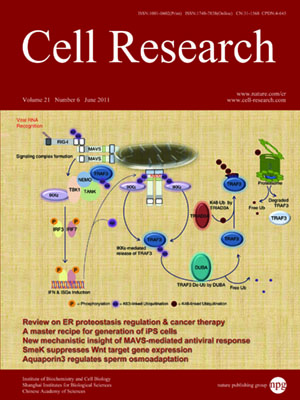
Volume 21, No 6, Jun 2011
ISSN: 1001-0602
EISSN: 1748-7838 2018
impact factor 17.848*
(Clarivate Analytics, 2019)
Volume 21 Issue 6, June 2011: 867-883
REVIEWS
Proteostasis regulation at the endoplasmic reticulum: a new perturbation site for targeted cancer therapy
Yanfen Liu and Yihong Ye
Laboratory of Molecular Biology, National Institute of Diabetes and Digestive and Kidney Diseases, National Institutes of Health, Bethesda, MD 20892-0540, USA
Correspondence: Yihong Ye,(yihongy@mail.nih.gov)
To deal with the constant challenge of protein misfolding in the endoplasmic reticulum (ER), eukaryotic cells have evolved an ER protein quality control (ERQC) mechanism that is integrated with an adaptive stress response. The ERQC pathway is comprised of factors residing in the ER lumen that function in the identification and retention of aberrantly folded proteins, factors in the ER membrane for retrotranslocation of misfolded polypeptides, and enzymes in the cytosol that degrade retrotranslocated proteins. The integrated stress response (termed ER stress or unfolded protein response, UPR) contains several signaling branches elicited from the ER membrane, which fine-tune the rate of protein synthesis and entry into the ER to match the ER folding capacity. The fitness of the cell, particularly those bearing a high secretory burden, is critically dependent on functional integrity of the ER, which in turn relies on these stress-attenuating mechanisms to maintain protein homeostasis, or proteostasis. Aberrant proteostasis can trigger cellular apoptosis, making these adaptive stress response systems attractive targets for perturbation in treatment of cell malignancies. Here, we review our current understanding of how the cell preserves ER proteostasis and discuss how we may harness the mechanistic information on this process to develop new cancer therapeutics.
Cell Research (2011) 21:867-883. doi:10.1038/cr.2011.75; published online 3 May 2011
FULL TEXT | PDF
Browse 2352


